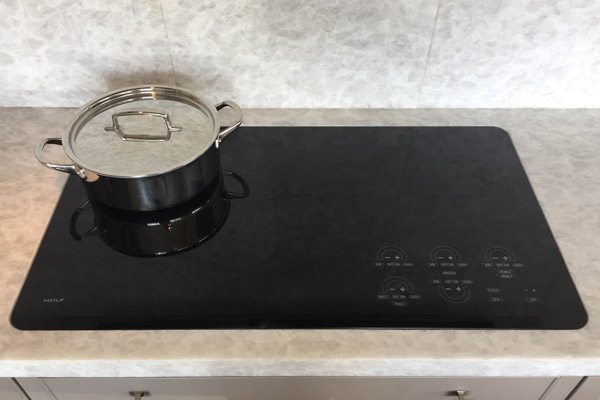Induction Cooking. Yes or no?
What is Induction Cooking?
How do you cook in your kitchen? With gas, electricity – or magnets?
Magnets power induction cooking and induction heat, an appliance technology developed in the early 1900s that’s gaining popularity today.
If you’ve only cooked with an electric or gas stove, you may be intrigued to learn about a different kind of cooking surface: one that doesn’t emit any heat is extremely durable and is more efficient than the traditional gas and electric stovetops you’re accustomed to.
While you may have heard of it, you may not know exactly how an induction stove works, what benefits this type of cooking surface provides and, most importantly, whether or not an induction cooktop is right for you. Read on to find out!
Here’s how Wolf explains it… “In induction cooking, the electricity flows through a coil to generate a magnetic field under the glass ceramic surface. When an induction-compatible pan is placed on the cooktop, currents are induced in the pan and instant heat is generated. The cooktop doesn’t heat up, the cookware does. It’s a cooking technology of startling precision, power, and efficiency.”
At Drury Design, our clients’ top two cooktop choices are: sleek induction or industrial grade gas. Here’s a quick guide to help you decide.
Induction Cooking Pros
Faster
Have a family of pasta lovers? Induction cooking will speed up your time to table by a few minutes. Wolf’s technology allows you to turn heating elements up or down to get an instantaneous response – up to 40% faster than gas or electric. Enabling cooks to save precious minutes when preparing meals.
More Energy Efficient
How much more energy efficient is induction versus gas? One test found induction was 32% faster and consumed 57% less energy than gas. Since an induction range cooks food more quickly and loses less heat while doing so, it is considered to be much more energy-efficient than both an electric stove top and a gas cooktop.
Cleaner
Compared to scrubbing greasy grates and mopping up spillovers on a gas range, wiping up a sleek induction cooktop surface is a snap. ince the unused portion of the induction cooktop remains relatively cool, most spills won’t cook onto the surface, making cleaning a breeze. All you need to wipe up any spills or splatters is a damp sponge or cloth. Some models have built-in overflow indicators that automatically switch off heat and sound an alarm when liquids spill onto the surface.
Safer
Heat stays with the cookware, not the cooktop. With no live flame, many families with children choose induction cooking. Since only the pan becomes hot and most of the cooktop stays cool during induction cooking, induction stoves provide a great safety feature, especially to households with young children. It’s important to note, however, that the heat from the pot does transfer from the surface below and around the pot. This means that if you’re using several induction elements at once, many parts of the surface will become hot as well. The lower cooking fumes output may also contribute to better indoor air quality.
Larger Cooking Area
Thermador’s Freedom™ Induction Cooktop delivers 63% more usable surface than most models, with 48 coils measuring 3″ each — offering the largest induction cooking surface on the market.

Induction Cooktop Cons
If the look of a live cooktop flame lights you up, then you’ll want to stick gas. Nothing else can match the aesthetic experience. And, some chefs feel like gas technology gives them greater temperature control.
Making the Switch
Although you won’t need a gas line, you will need a dedicated electrical conduit. You can keep your cast iron skillets and your Le Creuset cookware, but any non-magnetic pots and pans without flat bottoms like woks will have to go. You’ll also need to learn how to adjust the heat level by numbers, not flames.
What would you choose: gas or induction?
